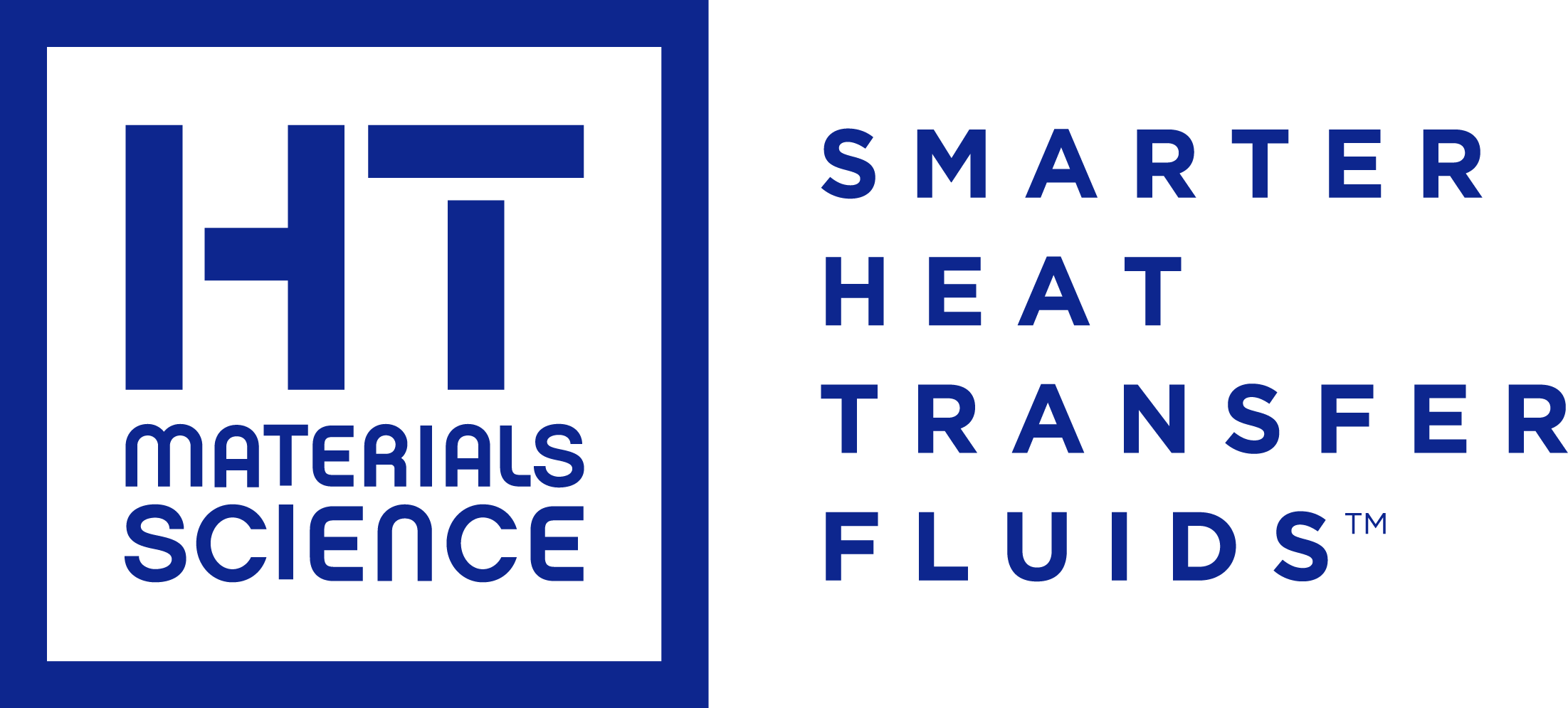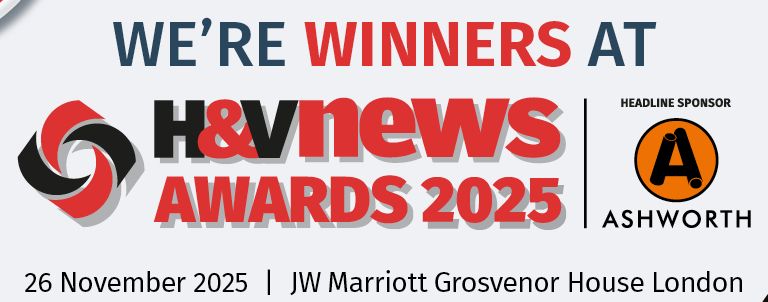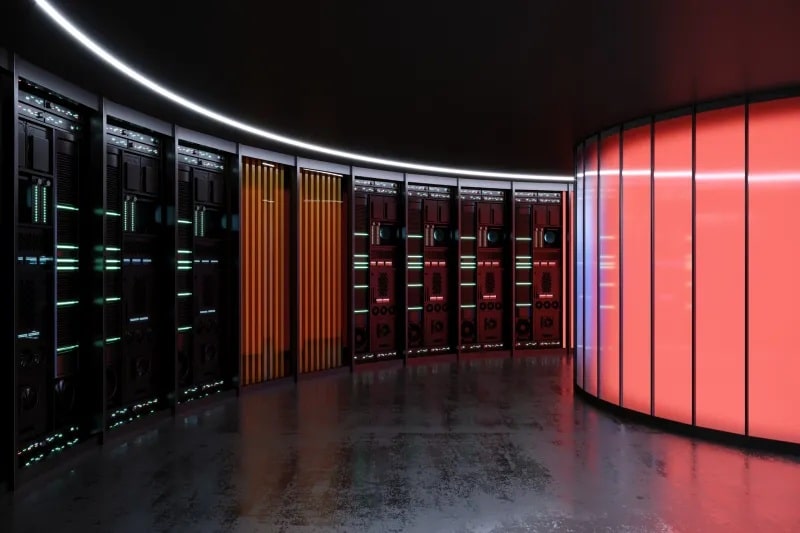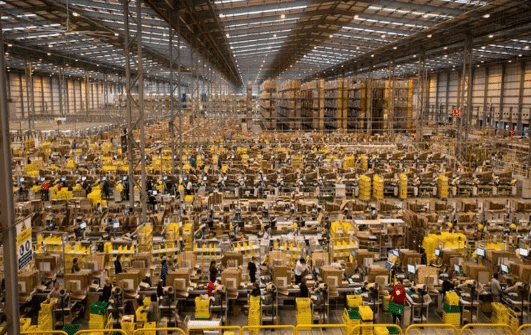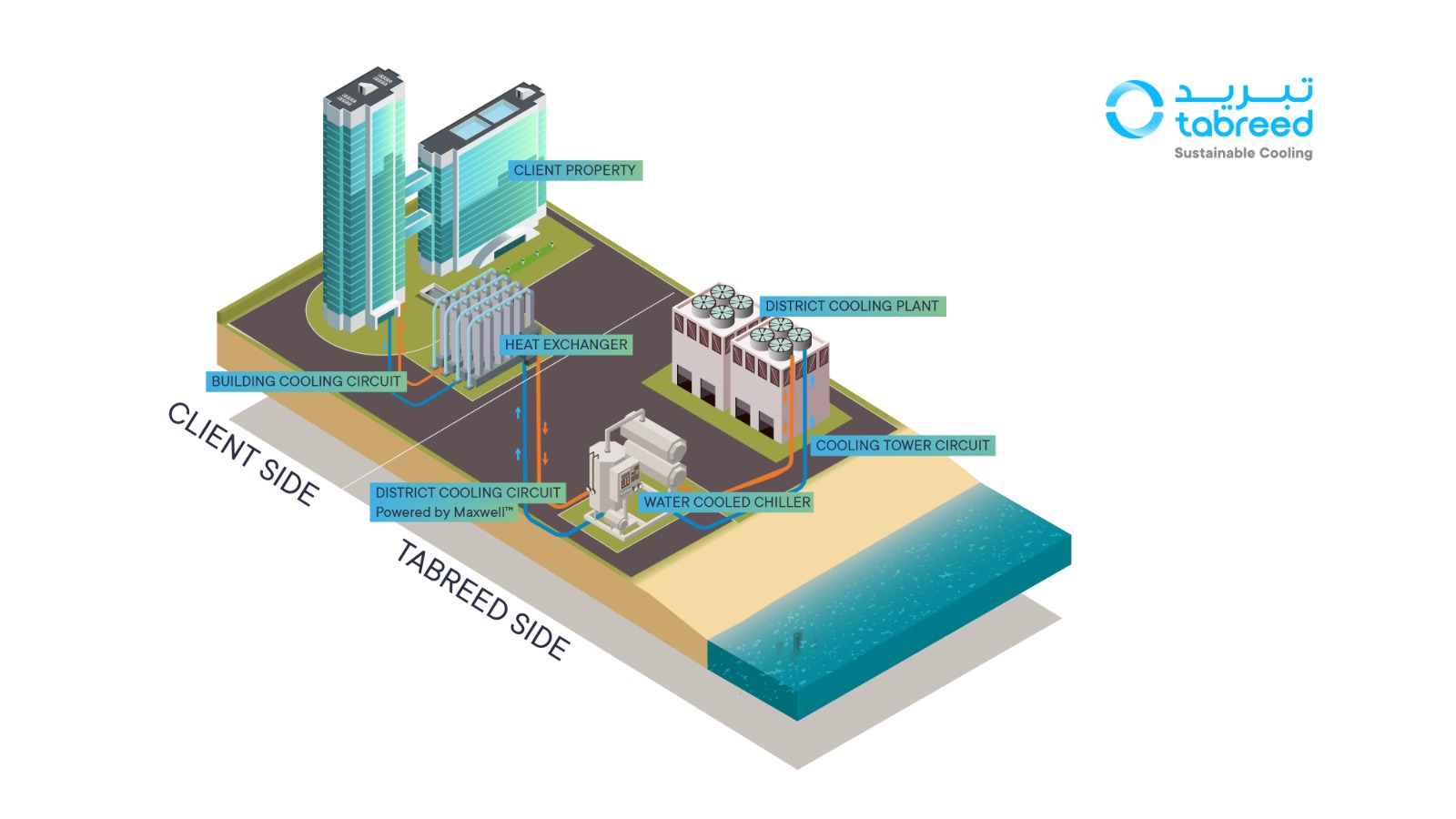HTMS Wins Heating & Ventilation News 2025 Award
H&V News Awards 2025 celebrated excellence across the heating, ventilation and air conditioning industry
01 December 2025
The 2025 H&V News Awards, the flagship event recognising the outstanding achievements of the HVAC sector, revealed its winners last night at a prestigious ceremony attended by industry leaders, innovators, and rising stars from across the sector.
Held in front of a packed audience, the awards honoured the organisations, projects, and individuals driving net zero progress and technical excellence across the built environment.
This year’s diverse range of finalists represented the very best businesses and professionals, who have demonstrated their commitment to shaping a safer, more efficient, and more environmentally responsible industry. From pioneering decarbonisation initiatives to groundbreaking product development and exceptional customer service, the 2025 winners exemplify the innovation and dedication transforming the sector.
HT Materials Science was awarded Commercial HVAC Product of the Year – Cooling Technology, with the H&V News Awards Judging Panel 2025 praising Maxwell for “its mature technology refined to new heights of performance, demonstrating thoughtful design and adaptability to market needs”.
Speaking at the ceremony, H&V News editor, Ella Mackenzie said:
“It was an honour to host these awards for the first time, and see the diverse range of talented professionals and incredible projects being undertaken across every corner of the UK, from small residential installations to huge industrial retrofits.
Thank you to everyone who took the time to share their work with us this year, both through their awards entries and through articles and case studies featured in the magazine. It’s been a pleasure to hear from you all, and I look forward to seeing what you accomplish in 2026”.
Reproduced from the original article
HTMS Secures €2.3m in DTIF Funding
A DCU consortium led by HT Materials Science Ltd (HTMS) has secured €2.3m in funding from the Disruptive Technologies Innovation Fund (DTIF) in Ireland
02 October 2025
The project, DLCool, is a collaboration between three partners, two based at DCU:Innovate Hub, HTMS and Exergyn Ltd, and DCU. The DCU academic leads are Dr Lorna Fitzsimons (School of Mechanical and Manufacturing Engineering) and Dr Darren Fayne (School of Chemical Sciences). DLCool was the only project to receive an award in the “manufacturing & materials” category of this call.
A defining strength of this collaboration is the close and growing integration between DCU researchers and innovation-driven companies based at DCU:Innovate Hub.
Denis Kearney, General Manager (Ireland), HT Materials Science Ltd, commented:
"We are delighted that our project has been approved under DTIF-7. This €3.7 million initiative, supported with €2.3million in grant aid, represents a major step forward in developing novel thermally conductive nanofluid additives for next-generation cooling solutions. As project lead, HTMS will drive innovation in direct liquid cooling for data centres, solid state heat pumps, and electric batteries - three critical sectors for Europe's energy transition. This award not only recognises the potential of our technology but also underlines Ireland's role in pioneering advanced materials to deliver both sustainability and performance at scale."
Kevin O’Toole, Co-Founder and CTO, Exergyn, added:
"This project brings together leading academic expertise and industrial know-how. We're excited to advance thermal management technologies, strengthen Ireland's manufacturing base, and open new commercial opportunities for our solid-state platform."
With this funding, DCU further consolidates its reputation as a research and innovation partner to industry, bridging AI, advanced manufacturing and thermal systems to industrial applications.
Commenting on this, Prof John Doyle, Vice-President for Research at Dublin City University, stated:
"DLCool exemplifies the power of collaboration between academia and industry and the importance of location on a university Innovation campus such as DCU:Innovate Hub. By combining DCU’s research excellence with the innovation capacity of our partners, this project has the potential to transform sustainable cooling technologies and deliver real impact for Ireland and beyond.”
Fast Company Award for 2025
HTMS selected by Fast Company as one of 10 most innovative companies in manufacturing for 2025
March 18th, 2025
Rob Pegoraro
Advances in manufacturing (faster, cheaper, smarter) don’t always result from one big technological breakthrough: much of the work of innovation involves building on what people have accomplished before.
Both P2 Science and HT Materials Science have drawn on their own inventions in chemistry to create cleaner and greener cosmetics and to make heating and air-conditioning systems more efficient and less thirsty for water. And since HT counts factories among its clients, future occupants of this list may rank among the beneficiaries of its work.
5. HT Materials Science
For identifying an additive that makes HVAC systems more efficient
The digital revolution giveth, and the digital revolution taketh away: On the one hand, smart technologies are improving energy efficiency; on the other, data centers and crypto-mining operations and fulfilment operations consume a massive and growing amount of energy that’s expected to double by 2030. About 40% of that consumption is attributable to energy required to keep operations cool.
Dublin-based startup HT Materials Science doesn’t make heating/ventilation/air-conditioning systems, but it does make the HVAC hardware already installed at commercial and industrial sites significantly more efficient. The company accomplishes this with its proprietary drop-in additive called Maxwell, which suspends microscopic particles of aluminum oxide in water or a mixture of water and glycol to improve heat transfer. Adding just a tiny bit to an HVAC system’s water or water-glycol mix helps juice efficiency by up to 20%.
HTMS has strategic partnerships with a number of prominent companies, including Regeneron and Saudi Aramco, and in May 2024 it was accepted into Amazon’s Sustainability Accelerator to deploy Maxwell at a trio of fulfilment centers in the U.K.
‑ Reproduced from original source
Forbes Council Article
How Commercial Building Owners Can Leverage Cost-Effective Retrofitting
Dec 23, 2024,07:45am EST
Thomas Grizzetti, CEO, HT Materials Science
As we prepare to leave 2024 behind and look ahead to 2025, it’s important to recognize how far the commercial HVAC industry has come—especially as businesses across the world continue seeking our help in reducing operating costs, carbon emissions and, of course, energy bills. It’s also important to think about what more we can be doing—and about just how impactful and far-reaching HVAC efficiency improvements can be when implemented at scale.
Companies are adopting greener, more energy-efficient systems. Energy efficiency standards, like those set by ASHRAE, are crucial drivers. These evolving standards are forcing companies to rethink their energy strategies. Local laws, such as New York’s Local Law 97, are further driving the need for more aggressive energy-efficiency measures, ensuring that cities continue progressing toward their decarbonization goals.
I haven’t always been passionate about the HVAC industry, but after several decades of investing in companies across a variety of sectors, I began to fully grasp the HVAC industry’s need for both innovation and reduced environmental impact. Now, as CEO of a company providing simple retrofit solutions for commercial HVAC systems, I recognize that upgrading HVAC equipment or replacing it entirely is not feasible for most companies. The path to a more sustainable HVAC future doesn’t have to rely solely on capital expenditures. Instead, businesses can explore lower-cost innovations, retrofits and optimizations to existing systems to reduce energy consumption and improve cost-efficiency.
Sustainability Isn’t Just About New Equipment
Sustainability shouldn’t come with a blanket prescription to “buy new.” In my experience, smart retrofitting can yield immediate benefits, including reduced energy consumption, without the high costs and operational disruptions of replacing entire systems.
For example, instead of replacing an entire HVAC system, companies can install more efficient compressors, variable-speed pumps or upgraded controls to maximize performance.
Retrofitting also has the added benefit of extending the lifespan of current systems, giving building owners more time before they need to consider a costly replacement. And, perhaps most importantly, retrofits involve less disruption to daily operations compared to full equipment replacement.
The Double-Edged Sword Of New Refrigerants
One area where the HVAC industry is seeing mandated change is refrigerants. For years, traditional refrigerants like R-410A have been used in HVAC systems. However, these refrigerants are being phased out due to environmental regulations aimed at protecting the ozone layer. The next wave of refrigerants is less harmful to the environment in terms of emissions, but they often come with a trade-off: lower efficiency.
Refrigerants play a critical role in heat transfer, and as newer, more environmentally friendly options are introduced, I believe the efficiency of HVAC systems will likely decrease. This change may be problematic for businesses trying to reduce their carbon footprint and control energy expenses. That said, a well-planned retrofit can maintain or increase system efficiencies and avoid skyrocketing energy costs.
Understanding Efficiency And The Grid
One of the hidden advantages of making HVAC systems more efficient is the relief it provides to the power grid. Energy-efficient systems consume less electricity, helping reduce strain on local power supplies. This reduced consumption can help prevent rolling brownouts or blackouts, which are increasingly common as the demand for energy-intensive services, such as data centers, grows. Retrofitting commercial buildings with more efficient HVAC systems can benefit both building owners and tenants by reducing electricity demand (especially during peak periods) and operating costs over time while keeping building temperatures comfortable.
District Energy: An Overlooked Champion
One area where significant sustainability gains are being made is district energy systems. These systems allow for the sharing of heating and cooling resources among multiple buildings or even cities, making them significantly more efficient than standalone HVAC systems. District energy systems can capture waste heat from one building—such as a data center—and use it to provide heating to other buildings nearby. This energy recovery can create a circular energy economy, reducing the need for additional energy production.
Preparing Your Building For A Retrofit
In order to understand and prepare for a retrofit, building owners must first understand whether the technology is suitable for their buildings. To start, building owners should review the past performance of the proposed retrofit, review the installation and maintenance procedures for potential disruption to operations, and, of course, have a keen understanding of the economics of the retrofit investment (i.e., ROI & payback), including any product warranties and performance guarantees.
Initially, building owners should focus on performance verification. This process starts with the review of energy efficiency data provided by the retrofit vendor for a building with similar size, construction type and cooling/heating loads as well as comparable HVAC equipment and seasonal operating metrics. Secondly, request and review any third-party performance certifications.
If you are satisfied that the data provided is acceptable, then the building owner must request and approve a measurement and verification (M&V) plan from the retrofit vendor. The M&V plan should include a protocol to compare the baseline operating metrics of the building before the installation of the retrofit to the new operating metrics of the building after the installation of the retrofit technologies. A generally accepted M&V protocol is the International Performance Measurement and Verification Protocol (IPMVP). Most M&V plans should run for 12 months with monthly reporting and periodic reporting thereafter.
Next, I would recommend a deep read into the installation and maintenance procedures. Generally, there should never be a material disruption to the operations of your building, and the existing building control system should be able to monitor, control and optimize the retrofit. Finally, owners should take steps to understand the economics. What are the annual energy savings versus retrofit cost (i.e. payback)? How does the payback compare to the ROI (i.e., useful life of retrofit/payback)?
These preparation procedures may seem daunting, but with proper due diligence, building managers in coordination with HVAC service will be able to make an informed decision.
The Future: Smarter, More Flexible Systems
The HVAC industry is nearing a plateau in squeezing more efficiency from traditional chiller and heat pump equipment. The next generation of technology must be smarter (e.g., AI-based system and building optimization strategies) and more adaptable. Building owners and operators should consider implementing a blend of retrofitting, improved controls and leveraging new technologies, as well as prioritizing solutions to deliver both short-term gains and long-term sustainability.
Ecovadis Bronze Medal for Sustainability
World-recognized organisation assesses the sustainability performance of companies
DUBLIN, Oct. 22, 2024
HT Materials Science recently applied for the EcoVadis global sustainability rating. We are proud to announce that we have been awarded the Bronze Medal in our first-ever rating.
EcoVadis is a world-recognized organisation which assesses the sustainability performance of companies by evaluating the environmental, social and ethical aspects of their operations.
Achieving the Bronze Medal demonstrates the HTMS commitment to sustainability and responsible business practices. It reflects the dedication and hard work of our employees in integrating sustainable principles and practices into our daily operations.
Our participation in the Ecovadis platform and network provides HTMS with valuable feedback and support in continuing to improve our ratings in each of the key evaluation categories, enhancing our company-wide efforts toward outstanding corporate sustainability.
Maxwell at Amazon UK Fulfilment Centers
HT Materials Science Selected by Amazon to Pilot Energy-Efficient Nanofluid Technology
DUBLIN, Oct. 21, 2024 /PRNewswire/
HT Materials Science (HTMS), a pioneering green tech company specializing in energy-efficient solutions, has been selected as one of eleven sustainability-focused start-ups that will trial their technology with Amazon across Europe after receiving funding in this year’s Amazon Sustainability Accelerator. HTMS will pilot its cutting-edge Maxwell™ nanofluid technology across three Amazon fulfilment centers in the UK—Coventry, Daventry, and Doncaster.
HTMS’ innovative solution is designed to improve the performance of heating, ventilation, and air conditioning systems (HVAC) by enhancing heat transfer efficiency. Maxwell™, which has already garnered international recognition, including the prestigious Green Product Award, is expected to reduce energy consumption in some of Amazon’s UK HVAC systems by up to 14%.
“We are thrilled to be piloting our technology with Amazon as part of this year’s Amazon Sustainability Accelerator,” said Ben Taylor, Vice President of HT Materials Science. “Maxwell™ has the potential to deliver significant energy savings and reduce the associated carbon emissions across the fulfilment centers. By improving the energy efficiency of these HVAC systems, we are supporting Amazon’s sustainability commitments and demonstrating the real-world impact of our technology.”
The pilot will kick off in 2024, with the technology being integrated into Amazon’s heating and cooling systems at key fulfilment centers. HTMS’ nanofluid solution has been designed to increase thermal conductivity, enabling HVAC systems to operate more efficiently without requiring additional energy inputs. The result is a reduction in energy use, lower operational costs and a significant decrease in carbon emissions.
A Potential Long-Term Partnership
Throughout the pilot, HTMS will work closely with Amazon’s subject matter experts and seek opportunities to refine its technology to ensure a successful implementation. Upon completion, the environmental impact, financial viability and overall effectiveness will be assessed to determine whether it can be scaled across other HVAC systems at Amazon sites as part of a long-term partnership.
HTMS is one of eleven start-ups from across Europe (as well as the US and Canada) that have been awarded the opportunity to test their innovations with Amazon operations.
About Amazon Sustainability Accelerator
Since its launch in 2022, the Amazon Sustainability Accelerator has supported over 40 start-ups across Europe and the UK. The initiative provides funding, mentorship, and the opportunity for start-ups to pilot their technologies within Amazon’s operations, with the goal of driving sustainable innovation and reducing the company’s environmental impact.
International EPD System Database lists Maxwell
HTMS are pleased to announce that after extensive due diligence by third-party environmental product specialists, Maxwell’s Life Cycle Analysis (LCA) has been approved and accepted by the International EPD System for listing on their database and website.
The full declaration is available here: https://www.environdec.com/library/epd11974
For most installations of Maxwell in Chilled Water Systems, the CO2 breakeven is less than one year on CO2 emissions saved, compared to the emissions generated during manufacturing and use of Maxwell, as shown in the LCA calculations. In many cases, the breakeven is just a few months.
The LCA assesses environmental impacts associated with all stages in the life cycle of a commercial product, process, or service. including materials procurement, production, shipping, installation, and End of Life (EOL). Maxwell is fully recoverable from the system fluid, and recyclable.
‑ Reproduced from original source
Maxwell Wins 2024 Green Product Award
HT Materials Science’s Pioneering Heat Transfer Fluid, Maxwell™,
Wins 2024 Green Product Award
May 1, 2024 (Dublin, IRELAND) – HT Materials Science (HTMS), the sustainable materials technology company based in Ireland with operations in Italy and the USA, was awarded the Green Product Award 2024 for their proprietary heat transfer fluid Maxwell™. A record of 1,500 applicants from 60 countries applied for the Awards, demonstrating the growing importance of sustainable products and materials in shaping a more sustainable future. Every year, the Green Product Award recognizes products and concepts that stand out in terms of design, innovation and sustainability. The winners in 12 categories have now been selected from 250 nominated products and concepts.
Maxwell won the Green Product Award 2024 in the Building Components category during the awards ceremony held on April 30th at the Nordic Embassies in Berlin. Embassy envoys and jurors such as Katarzyna Dulko-Gaszyna (IKEA Germany), Uwe Melichar (epda), Prof. Claus-Christian Eckhardt (Lund University), Katja Keienburg (baby&junior) presented the awards to winners from Austria, Belgium, Brazil, Canada, Denmark, Finland, Germany, Ireland, Israel, Italy, Netherlands, Nicaragua, Poland, Portugal, Spain, Sweden, Switzerland, Taiwan and the United Kingdom.
“Commercial and industrial cooling and heating applications in particular require a lot of energy and therefore cause considerable CO2 emissions. This innovative solution in the form of a heat transfer fluid can be retrofitted to existing systems, saves costs and demonstrably reduces energy consumption.” Official Jury Statement
Maxwell is an innovative heat transfer fluid additive that provides higher thermal capacity for water or water-glycol based HVAC systems. Improved fluid properties in cooling or heating systems are key to reducing energy use. HT Materials Science is in the vanguard to deliver the promise of nanofluid additives with the release of Maxwell.
About HTMS
HTMS is the producer of Maxwell – a patented drop-in heat transfer fluid additive for water based commercial and industrial HVAC systems. Maxwell increases the thermal energy transfer of HVAC systems, resulting in a substantial reduction in energy consumption and/or an increase in its thermal capacity. The company is headquartered in Ireland with offices in Italy, New York and Dubai. For more information visit www.htmaterialsscience.com
About the Green Product Award
Since 2013, the international Green Product Award has been honoring products and services that stand out in terms of design, innovation and sustainability. In cooperation with the IKEA Stiftung, the Green Concept Award evaluates concepts by young designers and supports their further development.
Media Contact:
htms@misfittoyscomms.com
‑ Reproduced from original source
Tabreed Boosts its Roadmap to Net-Zero
Tabreed Boosts its Roadmap to Net-Zero, following Impressive Results from World-first District Cooling Nanofluid Pilot Study
Thursday, November 09, 2023
Pioneering nanofluid technology, developed by HTMS, demonstrates potential to increase District Cooling energy efficiency by up to 15%
Abu Dhabi, United Arab Emirates – 09 November 2023: Tabreed, the world’s leading district cooling company, in partnership with Ireland-based HT Materials Science (HTMS), has concluded what is believed to be the world’s first pilot project of its kind, demonstrating results that provide real hope for significant gains in energy efficiency.
Applied across Tabreed’s current portfolio of 89 district cooling plants, the heat transfer fluid technology developed by HTMS – known as ‘Maxwell’ – could result in efficiency increases of between nine- and 15%. Theoretically this could mean preventing approximately 200,000 metric tons of greenhouse gas (GHG) emissions annually, as a result of decreased electrical energy consumption. For context, this would equate to removing 43,500 cars from the roads each year as a result of saving 335 million kWh of electricity, which is enough to power approximately 20,000 homes.
Maxwell, named after James Clerk Maxwell, the pioneering scientist who first developed the concept of nano fluids in the 19th century, is an engineered suspension of sub-micron aluminium oxide particles in a base fluid of water or water/glycol (‘nanofluid’) – a drop-in additive for cooling and heating systems, that works by enhancing heat transfer. It was trialled in the summer of 2023 at a Tabreed district cooling plant in Khalifah City, Abu Dhabi, which exclusively supplies chilled water to a 55,742 square metre educational campus.
The performance of the Maxwell nanoparticle fluid technology at Tabreed’s facility, evaluated under industry-approved Energy Efficiency Analysis (EEA), demonstrated that its addition increased efficiency of the plant’s chillers by 13.6%, leading to an overall plant efficiency improvement of 9.0%, compared with the same period in 2022.
Tabreed’s CEO, Khalid Al Marzooqi, said this development is testament to the company’s tireless pursuit of energy efficiency at every level of its operations, adding that “as a sustainable cooling champion focused on innovation, we are always looking for ways to accelerate the energy transition and provide more efficient services that benefit our customers, our stakeholders and the communities in which Tabreed operates.
“This successful pilot project proves the power of international partnership and technological collaboration, and we look forward to working with HTMS to further the application of their technology to advance sustainable cooling solutions that benefit communities and industries across the world.
“In real terms, what we are looking at here is a potentially seismic improvement in energy efficiency that could radically change this industry. That Tabreed is spearheading such developments should not be a surprise, and I am proud to be leading such a progressive and impactful company that’s completely aligned with the UAE’s inspirational Net-Zero strategy.”
How Maxwell Works in a Chilled Water System
Maxwell’s nanotechnology increases the thermal capacity of water, the base fluid for commercial and industrial chilled water systems. When added to a chilled water loop at a 2% concentration of nano materials, Maxwell increases the system’s cooling capacity by up to 15%. This increased cooling capacity allows chillers, fan units, pumps and other equipment to operate more efficiently, reducing electrical energy consumption and carbon emissions. Maxwell is a non-toxic, non-corrosive material and fully recoverable and recyclable.
Next Steps
Following the promising pilot study results, Tabreed and HTMS are in discussions to introduce the Maxwell technology to other district cooling facilities in the company’s portfolio. With cooling accounting for an estimated 70% of energy consumption in the GCC, and global demand expected to triple by 2050, this technology could potentially play a critical role in reducing the environmental impact of an industry already widely viewed as an essential contributor to sustainability, with district cooling being up to 50% more energy efficient than conventional cooling methods.
Commenting on the successful pilot project, Thomas Grizzetti, CEO of HTMS, said: “Thanks to the ease of installation, and use in both new and existing HVAC systems, Maxwell can have a material impact on energy usage and the carbon footprint of a broad range of industries and sectors globally. Maxwell is a significant step forward for businesses wishing to drive down energy use, increase system capacity and meet regulated energy efficiency targets increasingly promulgated by governments globally. We believe Tabreed is an ideal strategic partner for HTMS to help achieve widespread adoption of this unique technology.
‑ Reproduced from original source
The Currency: What HTMS plans to do after $15m funding round
THE CURRENCY | Tom Lyons, Chief Executive | March 24, 2023
The fluids traditionally used in heating and cooling are notoriously energy-inefficient, yet there has been no progress for decades in this area. With an easy-to-use product, HT Materials Science has caught the eye of high-profile global investors.

Tom Grizzetti was looking for his next investment six years ago. The search took him to the University of Salento in the historic city of Lecce in Italy, known as the Florence of the South. Grizzetti and his business partner, Irishman Ed Coleman, were looking to meet Professor Arturo de Risi and his team of materials science experts that were working on a product that the two veteran investors believed could change the world.
That revolution was not expected to happen in a dramatic or public way but out of sight in the vast heating, ventilation and air conditioning systems that keep offices and apartment blocks cool and are essential to manufacturing, data centres and all the other things that have become part of our existence.
“We were looking for additives and the effect they could have on energy efficiency,” Grizzetti explained on a video call from London after closing a $15 million Series A round for his business HT Materials Science.
It was an area the finance veteran didn’t know much about until about a decade ago when he and Coleman started to make a few small investments in the sector, prompted by an interest in refrigerants and their negative impact on the environment.
But now Grizzetti and Coleman were really excited about the potential of what de Risi and his team were working on as they delved deeper and got to know the Italian scientists. Over thirty-plus years, de Risi had his name on 11 patents in the thermal energy sector and was Professor of Engineering for Innovation at the University of Salento.
By January 2018, Grizzetti, Coleman and de Risi had founded a new business called HT Materials Science based in Dublin, Lecce and New York. Grizzetti was chief executive, with de Risi as CTO and Coleman as CFO.
The core product they developed is called Maxwell, a ground-breaking sub-micron heat transfer fluid technology that can be “dropped-in” as an additive to new or existing commercial and industrial heating and cooling systems, leading to a 15 per cent reduction in energy consumption.
Maxwell, if it can scale, could have a major impact on lowering energy costs, enhancing equipment performance and reducing carbon emissions. HT Materials Science believes its additive is so effective it can pay back the cost of using it to clients within two to three years. It has a compelling business as well as environmental case.
Grizzetti is telling me about the early days and potential of his business just after raising $15 million from some of the smartest investors in the world including Aramco Ventures, the venture arm of Saudi Aramco, and Barclays, via its Sustainable Impact Capital portfolio.
Italian asset management firm CDP Venture Capital SGR, through its corporate venture capital fund, Corporate Partners I, are also in the round, as is the Progress Tech Transfer fund, a sustainability-focused fund that specialises in working with Italian universities.
HT Materials Science has strong Irish links through a major research affiliation with Trinity College Dublin through AMBER (the Centre for Advanced Materials and BioEngineering Research funded by Science Foundation Ireland). Its executive chair is a Dubliner called Kyran McStay, a co-founder of Irish boutique advisory firm Key Capital, and a former managing director with UBS.
It took Tom Grizzetti a while to become a hands-on executive in a company again. For the previous 16 years, he had been president of his own investment firm called Gotham Industries. “I was doing some investing on behalf of myself and some friends,” Grizzetti said.
Working alongside him, seeking deals and managing investments was his friend Coleman. It was interesting and busy work but it wasn’t the graft of building a business from the ground up.
The last time Grizzetti did that was from 1995 until 2006 when he was chief operations officer and co-founder of alternative investment administrator firm International Fund Services (Ireland).
Grizzetti and his business partners built IFS (Ireland) into a $200 million revenue business. It had 1,200 employees when the business was acquired by State Street Bank in 2002, with a team of 700 in Dublin. Grizzetti stayed with the business until his earn-out finished in 2005, after taking the firm from scratch to global. While working with IFS (Ireland), Grizzetti got to know Coleman who was working with EY as audit partner to the business. He convinced Coleman to join him in the next phase of his career: investing.
They had lots of investments, but how heat transfer fluids were used in cooling and heating systems became a source of fascination. “We became really interested because of the size of the market and the effect on energy efficiency,” Grizzetti said. “We also realised it was an untouched market.”
There had been little innovation in the area of heat transfer fluids despite the surging need for cooling requirements in everything from offices to residential to manufacturing to data centres.
“A really elegant solution”
For decades, cooling and heating systems only used conventional fluids like water and glycol with low thermal conductivity, making them relatively inefficient. Grizzetti and Coleman felt the market was ready to be disrupted. They could see how de Risi and his team could improve the thermal conductivity of fluids to increase the efficiency of energy use, but they knew they needed to build a business to commercialise these ideas.
In January 2018, the inventors and investors teamed up to form a company called HT Materials Science. “We invested money and developed a newer version of heat transfer fluid which ended up becoming our product, Maxwell,” Grizzetti said. Maxwell is made out of sub-micron aluminium oxide particles and is non-corrosive and non-toxic, so it is safe too. “Maxwell is a really elegant solution,” Grizzetti said. “It is simple and not difficult to make or deploy.”
Initially, HT Materials Science was self-funded with between $1 million and $2 million. In summer 2020 it was ready to do a seed round of $2 million led by Progress Tech Transfer with the support of Enterprise Ireland and friends and family investors. “Effectively this allowed us to further develop our technology and do our first deployments in 2021,” Grizzetti said.
From the start, HT Materials Science worked with some of the best companies in the world who, like them, were eager to find new ways to reduce their energy needs. Regeneron Pharmaceuticals, Johnson & Johnson, Swire Pacific, Ericsson and Saudi Aramco deployed its product. Saudi Aramco was so interested in HT Materials Science that in August 2021 its venture arm led a €5 million investment round in the business.
“This became part of our $15 million series A round,” Grizzetti explained. HT Materials Science knew that Maxwell had huge potential. Consultants BCNP estimate that the product is compatible with 13.8 million systems in North America and Europe, an addressable market of over €50 billion a year. “The beauty of our product is that it is an additive so it is easy to retrofit as there is no additional capital expenditure required (to use it in existing systems),” Grizzetti said. “We can retrofit, say, a 500,000 sq ft office space in less than two days… in as little as 16 hours we can do it. In an active system, we can just pump in our additive while we drain fluid.” It was now time to really try and scale.

Kyran McStay became executive chairman of HT Materials Science in January 2022. He had known the firm’s co-founder Coleman for a decade, so he had been following the story, and had been asked to invest passively. “I said to Ed, this is a very interesting technology but I have decided I am only going to invest in businesses from now on where I get involved,” McStay recalled. “We stayed in touch and Ed informed me of progress. Then I got to meet Tom and to really understand the business.” McStay gradually got drawn in, until he accepted the role of chairman accepted the role of chairman.
“What attracted me first and foremost was the quality of the management team,” McStay said. “Ed and Tom have been around the block. They know how to build large organisations.”
“We have a management team capable of scaling this business very quickly, commercialising our technology, building a distribution platform and developing adjacent technologies. I loved the business challenge and found the prospect of working with the team really exciting.”
HT Materials Science’ $15 million series A round was raised in two chunks. The first part was led by Aramco Ventures and the second part by CDP, part of the Italian sovereign wealth fund, as well as Barclays through its Sustainable Impact Capital portfolio, led by Barclays’ Principal Investment team.
When the full round closed recently, this took HT Materials Science total funding to date to $20 million.
Grizzetti said the new funding would allow it to start to build a global sales team and continue to invest in R&D to bring the next version of its product to trial stage at the end of this year. “We are excited to have the backing of Aramco Ventures, Barclays, CDP and PTT. This support from major industry innovators serves as a strong endorsement for our technology and vision,” he said. “Thanks to the ease of installation, and use in both new and existing HVAC (heating, ventilation and air conditioning) systems, we believe that, at scale, Maxwell can have a material impact on energy usage and the carbon footprint of a broad range of industries and sectors.”
HT Materials Science employs 25 people but expects this to go to 35 in the next 12 months or so. In Italy, it has manufacturing capabilities to produce enough product to support sales of up to $20 million. But as Maxwell establishes itself, HT Materials Science intends to migrate to an indirect model using existing sales channels of large energy service companies, facilities managers and original equipment manufacturers to scale. Having its new investors on board will also help. “When you bring in a new investor, one thing is cash but the other is routes to market and commercial validation,” Grizzetti said. “Investors like Aramco Ventures and Barclays give us credibility and help us get to market.”
“Barclays is doing this investment on the bank’s balance sheet as part of its sustainability plan,” he added. “They own a large portfolio of real estate and they can open doors for us.”
Industrial need
Grizzetti said offices and large-scale residential developments were one area they hoped to deploy in, but the other was in industrial applications and data centres. “The industrial area is probably going to be the bigger market for us as they are high energy users who need cooling 24/7,” he said. “I’m sitting here in London so the demand for cooling is low because of the ambient temperature. I think our speciality in the long run will be more on the industrial side but we are focusing on both markets.”
Grizzetti is ambitious for HT Materials Science, and itching to grow. “If we are correct, we will have established a pretty good client base in America, Europe, Asia and GCC (Gulf Cooperation Council countries) in the next few years. We will have completed a series B round of between $25 million and $35 million,” he predicted.
“We will have multiple manufacturing facilities whether in or out of house, which will allow us to become a global business. We have an elegant and simple solution predicated on a known technology that can deliver real energy savings and make a real impact.”
‑ Reproduced from original source

